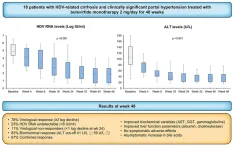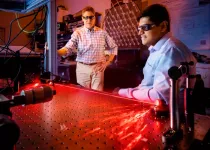(Press-News.org) New University of Limerick, Ireland research has revealed that most treatments being offered to teenagers with persistent back pain are ‘outdated’ and ignore ‘big picture’ issues.
The study, carried out by researchers at University of Limerick along with colleagues in the UK and Australia, has shown that new approaches to tackling back pain are not being tested among teenagers.
The research, published in the European Journal of Pain, reveals that there is a lack of treatments addressing the needs of teenagers with persistent nonspecific back pain.
It shows specifically that treatments for adolescents with persistent back pain have primarily relied upon an outdated, biomechanical explanation of persisting pain. Rather, treatment should align with current recommendations that both mind and body be addressed when back pain is present.
Back pain is the biggest cause of disability in the world, and it starts for many people when they are teenagers. In fact, teenagers can suffer considerably with back pain, missing out on school, sports, and social engagement.
There was a time when it was assumed that back pain in teenagers was caused mostly by physical factors such as posture and heavy schoolbags. However, it is now accepted that back pain is influenced by factors such as sleep, physical activity, mood, and stress.
This more holistic understanding of back pain has led to a range of innovative treatments being offered to adults with low back pain, treatments which consider not just the back, but also the person’s overall health and well-being.
However, the scoping review carried out by the UL team, led by PhD researcher Sara D Hauber and Professor Kieran O’Sullivan of the School of Allied Health and the Health Research Institute at UL, has shown that these new approaches are not being tested among teenagers with back pain.
Instead, most treatments being offered to teenagers with back pain tend to ignore the ‘big picture’ issues such as sleep, mood, stress, and relationships.
“Traditional approaches such as exercise can play a useful role in helping teenagers with back pain,” explained PhD researcher Sara D Hauber.
“However, exercise alone is rarely enough, and we have good evidence that other factors can have a major impact on a person’s pain.”
According to co-author Professor Kieran O’Sullivan there may be several reasons for the lack of treatments addressing the needs of teenagers with back pain.
“First, this may partly reflect old-fashioned ideas about what causes back pain, where the latest science is not fully appreciated. In this scenario, we spend too much time worrying about which specific exercise is best, rather than acknowledging almost all exercise is good, and we should also consider ‘other stuff’ going on in their life.
“Secondly, the way healthcare services are offered, and how professionals are trained, makes a ‘joined-up’ approach to treating back pain difficult and it rarely looks at the whole person.
“For example, if a teenager has back pain, poor sleep, and low mood – each of which might be connected – they may be seeing multiple healthcare professionals, each of whom is trained to treat only one or two of these symptoms, often only for a short period of time, and who are likely unable to communicate with each other easily using electronic health records.
“To help teenagers with back pain recover better, we need to trial these new treatments, and to structure healthcare in a way where physical and mental health are considered together,” Professor O’Sullivan explained.
The new research builds on previous studies carried out at UL by Professor O’Sullivan that have challenged previously accepted thinking on the treatment of back pain.
One recent study showed that people who received personalised treatment, which specifically matched their health needs, did better than those who received similar recommended care in a non-personalised manner, while another demonstrated that that common understanding of ‘proper’ sitting posture was outdated and may in fact hinder the treatment of back pain.
ENDS
The study, ‘Describing the nonsurgical, nonpharmacological interventions offered to adolescents with persistent back pain in randomized trials: A scoping review’, by Sara D. Hauber, Kieran O'Sullivan and others, has been published by the journal European Journal of Pain. It is available here: https://onlinelibrary.wiley.com/doi/10.1002/ejp.2073.
For further information, please contact:
Alan Owens
Communications Officer
University of Limerick
+353 87 908 6633
alan.owens@ul.ie
About University of Limerick:
University of Limerick is a research-led, independent, internationally focused university with more than 18,000 students and 1,800 staff. It is a young, energetic and enterprising university with a proud record of innovation in education and excellence in research and scholarship.
More information is available at www.ul.ie.
Tweet @UL
Facebook.com/universityoflimerick
LinkedIn University of Limerick
END
AAV is a multi-organ disease, which can be complex and may vary from person to person. Types of AAV include granulomatosis with polyangiitis (GPA), microscopic polyangiitis (MPA), and eosinophilic granulomatosis with polyangiitis (EGPA). This variety can make management challenging. Comorbidities, an individual’s history, toxicities, medication availability and cost, and patient preferences should all be considered in the process of informed decision making.
EULAR first wrote recommendations ...
Amsterdam, March 20, 2023 – In 2020, bulevirtide (BLV) was conditionally approved for treating chronic hepatitis delta (CHD), an inflammation of the liver caused by hepatitis D virus (HDV). Now real-world studies of patients treated outside of clinical trials confirm that long-term suppressive therapy with BLV monotherapy has the potential to reduce viral replication and improve liver tests of these difficult-to-treat patients for the first time in 45 years, report investigators in the Journal of Hepatology and its companion journal JHEP Reports.
Two of the studies, led by Pietro Lampertico, MD, PhD, Division of Gastroenterology and Hepatology, Foundation IRCCS Ca’ ...
ALBUQUERQUE, N.M. — In a major breakthrough in the fields of nanophotonics and ultrafast optics, a Sandia National Laboratories research team has demonstrated the ability to dynamically steer light pulses from conventional, so-called incoherent light sources.
This ability to control light using a semiconductor device could allow low-power, relatively inexpensive sources like LEDs or flashlight bulbs to replace more powerful laser beams in new technologies such as holograms, remote sensing, self-driving cars and high-speed ...
How fresh are your data? For drones searching a disaster zone or robots inspecting a building, working with the freshest data is key to locating a survivor or reporting a potential hazard. But when multiple robots simultaneously relay time-sensitive information over a wireless network, a traffic jam of data can ensue. Any information that gets through is too stale to consider as a useful, real-time report.
Now, MIT engineers may have a solution. They’ve developed a method to tailor any wireless network to handle a high load of time-sensitive data coming from multiple sources. Their new approach, ...
The human body is made up of thousands of tiny lymphatic vessels that ferry white blood cells and proteins around the body, like a superhighway of the immune system. It’s remarkably efficient, but if damaged from injury or cancer treatment, the whole system starts to fail. The resulting fluid retention and swelling, called lymphedema, isn’t just uncomfortable — it’s also irreversible.
When lymphatic vessels fail, typically their ability to pump out the fluid is compromised. Georgia Institute of Technology researchers have developed a new treatment using nanoparticles that can repair lymphatic vessel pumping. Traditionally, ...
The Chicago Quantum Exchange (CQE) continued to expand its diverse community of quantum researchers, leaders, and institutions in 2022—launching a quantum research fellowship for undergraduates, welcoming 11 new corporate partners, and extending a regional quantum communication network to a total length of 124 miles.
These are among the successes highlighted in the CQE’s newly published annual report, which chronicles the many contributions of the consortium’s members and partners and offers a window into the region’s ...
Drifting along in ocean currents, jellyfish can be both predator and prey. They eat almost anything they can capture, and follow the typical oceanic pattern of large eats small. Now a recent University of British Columbia study on these gelatinous globs suggests jellyfish may get more nutritious as they get bigger.
As jellyfish grow, their size changes largely due to the chances of prey encounter, the length and number of tentacles, and their bells (the umbrella-like part of them). As a result, smaller jellyfish eat phytoplankton, microzooplankton, and eggs, while larger jellyfish can eat all of that plus shrimp and even fish. However, ...
An international research team led by the Netherlands Institute of Ecology (NIOO-KNAW) is to search for invisible life in the Galápagos Islands. The diversity of bacteria and other microscopic organisms may not be evident to the naked eye, but it is essential to nature. To the islands' giant daisies, for instance: unique endemic plants that are currently under threat.
How unique and diverse is the invisible microbial life of the iconic Galápagos Islands? That's what the Galápagos Microbiome Project - a group of scientists from the Netherlands, ...
Future ocean warming and marine heatwaves could impact the growth and development of clownfish during their earliest life stages, suggests a new study recently published in the journal, Science of The Total Environment.
A team of marine biologists from the Okinawa Institute of Science and Technology (OIST) reared the iconic coral reef fish in captivity at water temperatures of either 28°C or 31°C. Temperatures of 28°C represent current summer seawater temperatures in Okinawa, whilst temperatures of 31°C are reached during ...
Cancer, in all of its forms, is a public health concern responsible for more than 8 million deaths each year in the United States. In addition to its effect on patients and the health care system in general, cancer also places a burden on non-professional caregivers such as family members and friends. This can be especially true for the Hispanic population, where communication barriers, financial difficulties and sociocultural issues can be significant.
In a recently published review article, Jasbir ...







